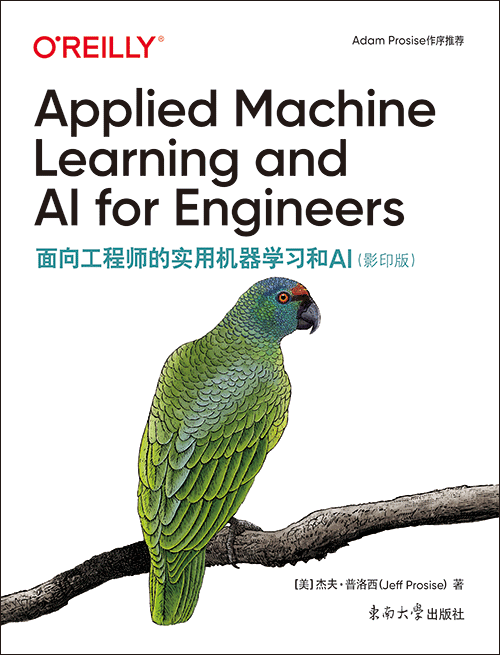面向工程师的实用机器学习和AI(影印版)
出版时间:2023年03月
页数:400
“如果你想搞明白AI和机器学习究竟是如何工作的,以及这些技术的演变历程和未来发展,那就读读这本书吧。”
——Todd Fine
Atmosera首席战略官“读了这本书会让你忍不住跃跃欲试。”
——Doug Turnure
Microsoft Azure专家
许多AI入门指南可以说都是变相的微积分书籍,但这本书基本上避开了数学。作者Jeff Prosise帮助工程师和软件开发人员建立了对AI的直观理解,以解决商业问题。需要创建一个系统来检测雨林中非法砍伐的声音、分析文本的情感或预测旋转机械的早期故障?这本实践用书将教你把AI和机器学习应用于职场工作所需的技能。
书中的示例和插图来自于Prosise在全球多家公司和研究机构教授的AI和机器学习课程。不说废话,也没有可怕的公式 —— 纯粹就是写给工程师和软件开发人员的快速入门,并附有实际操作的例子。
本书将帮助你:
● 学习什么是机器学习和深度学习及其用途
● 理解流行的机器学习算法原理及其应用场景
● 使用Scikit-Learn在Python中构建机器学习模型,使用Keras和TensorFlow构建神经网络
● 训练回归模型以及二元和多元分类模型并给其评分
● 构建面部识别模型和目标检测模型
● 构建能够响应自然语言查询并将文本翻译成其他语言的语言模型
● 使用认知服务将AI融入你编写的应用程序中
——Todd Fine
Atmosera首席战略官“读了这本书会让你忍不住跃跃欲试。”
——Doug Turnure
Microsoft Azure专家
许多AI入门指南可以说都是变相的微积分书籍,但这本书基本上避开了数学。作者Jeff Prosise帮助工程师和软件开发人员建立了对AI的直观理解,以解决商业问题。需要创建一个系统来检测雨林中非法砍伐的声音、分析文本的情感或预测旋转机械的早期故障?这本实践用书将教你把AI和机器学习应用于职场工作所需的技能。
书中的示例和插图来自于Prosise在全球多家公司和研究机构教授的AI和机器学习课程。不说废话,也没有可怕的公式 —— 纯粹就是写给工程师和软件开发人员的快速入门,并附有实际操作的例子。
本书将帮助你:
● 学习什么是机器学习和深度学习及其用途
● 理解流行的机器学习算法原理及其应用场景
● 使用Scikit-Learn在Python中构建机器学习模型,使用Keras和TensorFlow构建神经网络
● 训练回归模型以及二元和多元分类模型并给其评分
● 构建面部识别模型和目标检测模型
● 构建能够响应自然语言查询并将文本翻译成其他语言的语言模型
● 使用认知服务将AI融入你编写的应用程序中
- Foreword
- Preface
- Part I. Machine Learning with Scikit-Learn
- 1. Machine Learning
- What Is Machine Learning?
- Unsupervised Learning with k-Means Clustering
- Supervised Learning
- Summary
- 2. Regression Models
- Linear Regression
- Decision Trees
- Random Forests
- Gradient-Boosting Machines
- Support Vector Machines
- Accuracy Measures for Regression Models
- Using Regression to Predict Taxi Fares
- Summary
- 3. Classification Models
- Logistic Regression
- Accuracy Measures for Classification Models
- Categorical Data
- Binary Classification
- Multiclass Classification
- Building a Digit Recognition Model
- Summary
- 4. Text Classification
- Preparing Text for Classification
- Sentiment Analysis
- Naive Bayes
- Spam Filtering
- Recommender Systems
- Summary
- 5. Support Vector Machines
- How Support Vector Machines Work
- Hyperparameter Tuning
- Data Normalization
- Pipelining
- Using SVMs for Facial Recognition
- Summary
- 6. Principal Component Analysis
- Understanding Principal Component Analysis
- Filtering Noise
- Anonymizing Data
- Visualizing High-Dimensional Data
- Anomaly Detection
- Summary
- 7. Operationalizing Machine Learning Models
- Consuming a Python Model from a Python Client
- Versioning Pickle Files
- Consuming a Python Model from a C# Client
- Containerizing a Machine Learning Model
- Using ONNX to Bridge the Language Gap
- Building ML Models in C# with ML.NET
- Adding Machine Learning Capabilities to Excel
- Summary
- Part II. Deep Learning with Keras and TensorFlow
- 8. Deep Learning
- Understanding Neural Networks
- Training Neural Networks
- Summary
- 9. Neural Networks
- Building Neural Networks with Keras and TensorFlow
- Binary Classification with Neural Networks
- Multiclass Classification with Neural Networks
- Training a Neural Network to Recognize Faces
- Dropout
- Saving and Loading Models
- Keras Callbacks
- Summary
- 10. Image Classification with Convolutional Neural Networks
- Understanding CNNs
- Pretrained CNNs
- Using ResNet50V2 to Classify Images
- Transfer Learning
- Using Transfer Learning to Identify Arctic Wildlife
- Data Augmentation
- Global Pooling
- Audio Classification with CNNs
- Summary
- 11. Face Detection and Recognition
- Face Detection
- Facial Recognition
- Putting It All Together: Detecting and Recognizing Faces in Photos
- Handling Unknown Faces: Closed-Set Versus Open-Set Classification
- Summary
- 12. Object Detection
- R-CNNs
- Mask R-CNN
- YOLO
- YOLOv3 and Keras
- Custom Object Detection
- Summary
- 13. Natural Language Processing
- Text Preparation
- Word Embeddings
- Text Classification
- Neural Machine Translation
- Bidirectional Encoder Representations from Transformers (BERT)
- Summary
- 14. Azure Cognitive Services
- Introducing Azure Cognitive Services
- The Computer Vision Service
- The Language Service
- The Translator Service
- The Speech Service
- Putting It All Together: Contoso Travel
- Summary
- Index
书名:面向工程师的实用机器学习和AI(影印版)
作者:Jeff Prosise 著
国内出版社:东南大学出版社
出版时间:2023年03月
页数:400
书号:978-7-5766-0657-7
原版书书名:Applied Machine Learning and AI for Engineers
原版书出版商:O'Reilly Media
The animal on the cover of Applied Machine Learning and AI for Engineers is a festive parrot (Amazona festiva), also known as a festive amazon. Festive parrots live in the tropical forests, woodlands, and coastal mangroves of several South American countries, including Brazil, Colombia, Ecuador, Peru, and Bolivia. They are rarely found far from water.
Festive parrots are brightly—you might even say festively—colored, medium-sized birds. Their plumage is predominantly a striking green, turning slightly yellow toward the edges of their wings. A motley assortment of colors—including red, blue, and sometimes yellow or orange—adorns their faces.
Festive parrots are a highly social species, usually spotted in pairs or small flocks. Large groups of the birds often gather at night for communal roosts or around a localized food source and are known for being incredibly noisy. They enjoy eating fruits such as mangoes and peach palm, with berries, nuts, seeds, flowers, and leaf buds supplementing their diet.
While still relatively common where their forest habitat remains largely intact, festive parrots have been categorized by IUCN as near threatened due to continued deforestation and predicted declines in habitat.
Festive parrots are brightly—you might even say festively—colored, medium-sized birds. Their plumage is predominantly a striking green, turning slightly yellow toward the edges of their wings. A motley assortment of colors—including red, blue, and sometimes yellow or orange—adorns their faces.
Festive parrots are a highly social species, usually spotted in pairs or small flocks. Large groups of the birds often gather at night for communal roosts or around a localized food source and are known for being incredibly noisy. They enjoy eating fruits such as mangoes and peach palm, with berries, nuts, seeds, flowers, and leaf buds supplementing their diet.
While still relatively common where their forest habitat remains largely intact, festive parrots have been categorized by IUCN as near threatened due to continued deforestation and predicted declines in habitat.
购买选项
